Operating hours: 10:00 AM to 9:00 PM,
Closed on Tuesdays
"Retro Cafe": available during the Planetarium’s operating hours from 10:00 AM to 8:00 PM.
Contact number: +7 (495) 221-76-90
Planetarium JSC © 2017. Located at 5 Sadovaya-Kudrinskaya str., building 1, Moscow.
The dwarf planet Pluto is celebrating its 13th birthday
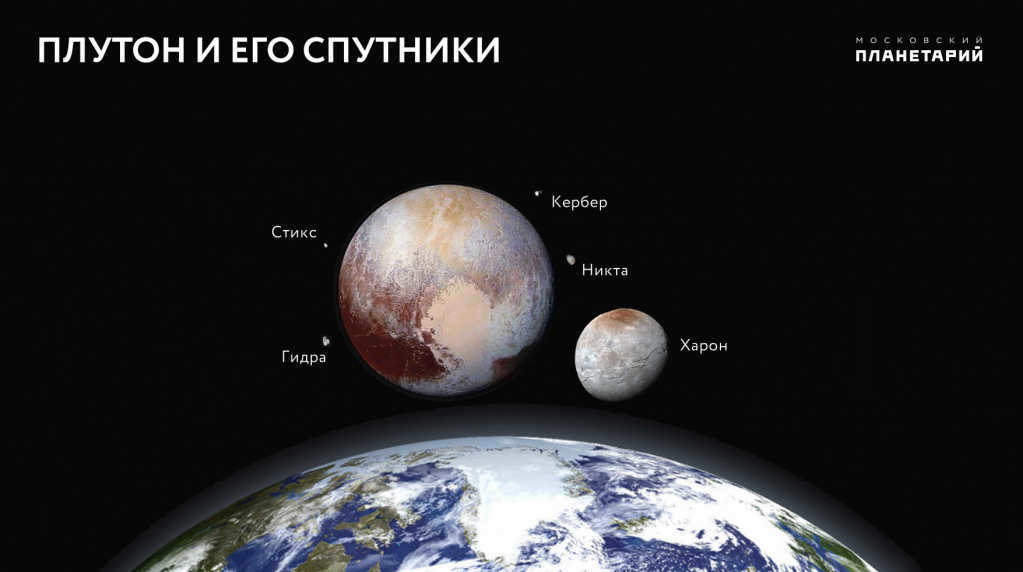
Date: 23.08.2019.
Pluto lost its status as a planet in the solar system on August 24, 2006. The decision was made by the XXVI General Assembly of the International Astronomical Union (IAU) during their meeting in Prague, Czech Republic from August 14 to 25, 2006. Pluto was reclassified as a “dwarf planet”. The World Forum of Astronomers also participated in the decision-making process. In addition to the “traditional planets” and “dwarf planets”, the Solar System now includes “small celestial bodies” such as asteroids and comets.
Why Isn’t Pluto Considered a Planet?
Pluto failed to clear its orbit of other objects, which is the main reason it was excluded from being classified as a planet in the solar system and placed in a new category of celestial bodies called dwarf planets.
For an object to be considered a planet in the solar system, it must meet four criteria set by the International Astronomical Union (IAU):
- The object must orbit the Sun. – Pluto meets this requirement.
- It must be large enough to have a spherical shape due to its own gravitational force – Pluto seems to meet this criterion.
- It doesn’t have to be a moon of another object – Pluto itself has five moons.
- Pluto’s inability to clear the space around its orbit of other objects is the primary reason why it is not classified as a planet.
If an object fails to meet the fourth criterion, it is designated as a dwarf planet. Hence, Pluto falls into the category of a dwarf planet.
Therefore, August 24, 2006 marks the birthdate of Pluto, the first and largest dwarf planet.
Pluto
Pluto (134340 Pluto) is the largest known dwarf planet in our solar system.
There are five natural satellites that orbit around Pluto: Charon, Nycta, Hydra, Kerberus, and Styx. The largest of these is Charon, which has a mass equal to half of Pluto’s mass.
Similar to other objects in the Kuiper Belt, Pluto is predominantly made up of rock and ice. It is relatively small, with a mass that is six times less than that of the Moon and a volume that is three times less than that of the Moon. The surface area of Pluto is approximately equivalent to the size of Russia.
Classification of 5 Dwarf Planets
The International Astronomical Union has officially classified five celestial bodies as dwarf planets. These include Ceres, the largest asteroid in our solar system, as well as the transneptunian objects Pluto, Erida, Makemake, and Haumea.
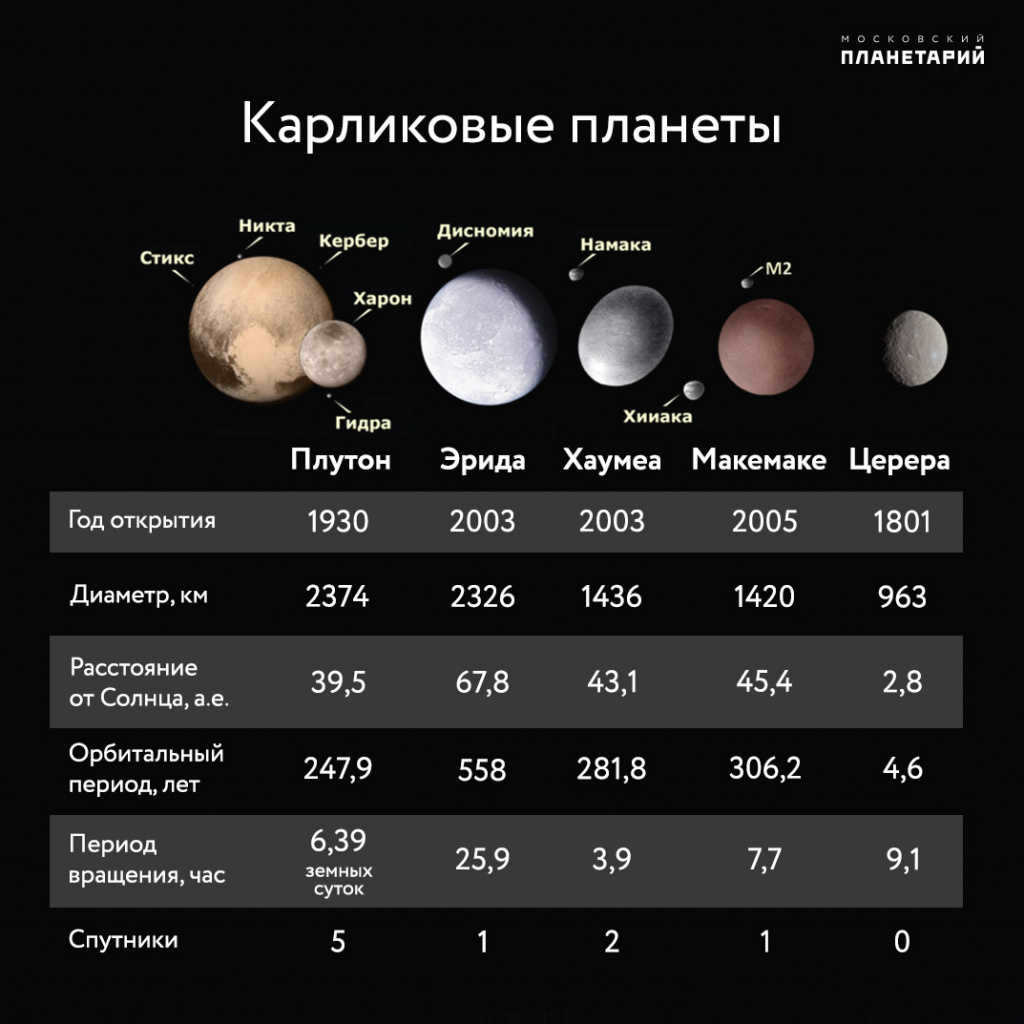
New Horizons mission (New Horizons IOA)
It is worth noting that back in January 2006, NASA embarked on an ambitious mission by launching the New Horizons interplanetary spacecraft with the goal of exploring Pluto, which was then considered the ninth planet in our solar system. After an incredible journey spanning 9.5 years and covering a distance of 5 billion kilometers, the New Horizons MSCA finally reached its destination on July 15, 2015. However, by that time, Pluto had already been reclassified as a dwarf planet. Nonetheless, New Horizons managed to capture and transmit the first-ever close-up photograph of Pluto, marking a historic milestone in space exploration.
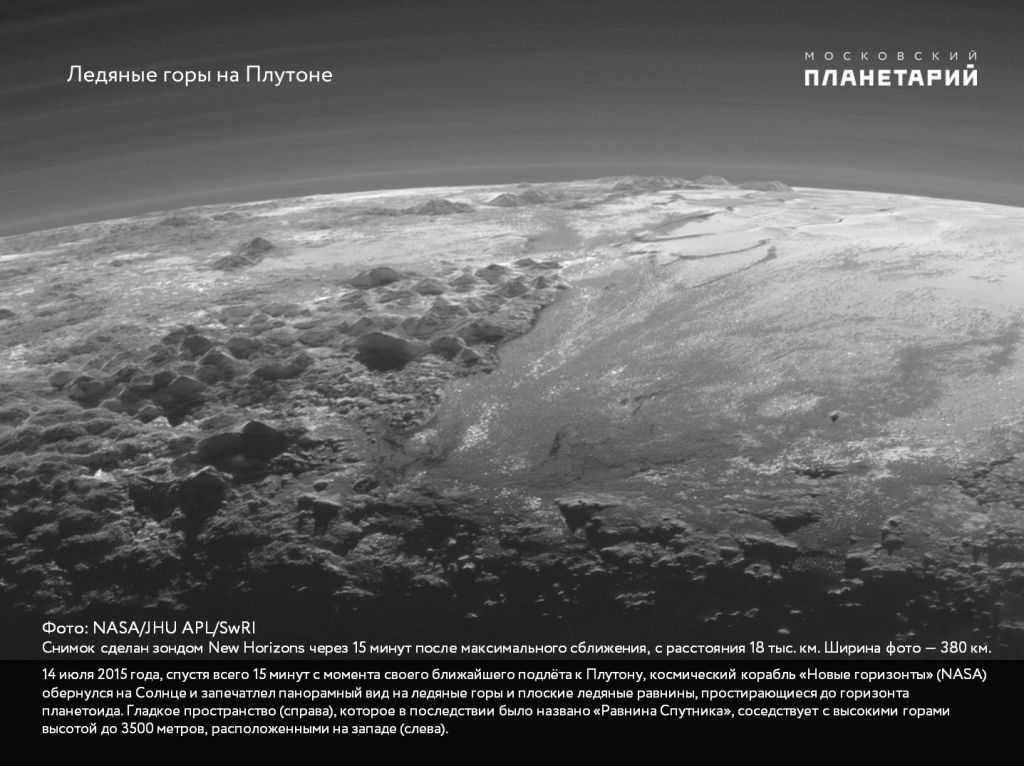
July 14, 2015. The New Horizons spacecraft completed a flyby of Pluto on this date, coming as close as 12,500 kilometers to the surface of the dwarf planet. During this time, the spacecraft captured a multitude of photographs and gathered valuable scientific data about the composition of Pluto’s surface and atmosphere. Over the course of 9 days, New Horizons collected approximately 50 gigabits of data.
The transmission of this scientific data back to Earth took place over a period of several months and was completed on October 25, 2016.
On December 5, 2017. At a distance of 6.12 billion kilometers (40.9 astronomical units) from Earth, the New Horizons spacecraft used its Multicolor Visible Imaging Camera (MCA) to capture images of two trans-Neptunian objects: 2012 HZ84 and 2012 HE85. The images were taken from distances of 0.50 and 0.34 astronomical units, respectively, and the photographed bodies had estimated diameters of approximately 42 and 51 kilometers.
August 2018 – The New Horizons MCA conducted another measurement and identified a rise in ultraviolet emissions emanating from the opposite direction of the Sun. This phenomenon can be attributed to the presence of a “hydrogen wall” encircling the solar system, which represents a region of interstellar matter compression at the edge of the solar wind propagation. Comparable observations were also recorded by the Voyager spacecraft three decades ago.
On January 1, 2019, New Horizons, after passing Pluto, came within just 3,500 kilometers of the surface of a Kuiper Belt object named MU69 2014, also known as "Ultima Thule" (which translates to "beyond the known world"). This encounter occurred when the spacecraft was 6.6 billion kilometers away from the Sun. The images captured during this close flyby revealed the extraordinary shape of Ultima Thule, resembling either a snowman or a flower with two elongated petals measuring 35 km in length. One petal, nicknamed Ultima, is significantly larger than the other petal, Thule. This peculiar shape was the most astounding discovery of the mission, as it is unlike anything ever observed in the entire solar system.
Surface Map of Pluto
In 2015, the New Horizons AMS captured images revealing a large bright region shaped like a heart, measuring 1800×1500 km. In the equatorial region, there are prominent 3.5-kilometer-long mountains on Pluto’s generally smooth icy surface, possibly composed of water ice. These mountains, along with other surface features, have been provisionally named. The most significant geological feature discovered on Pluto is the Sputnik Plain. This depression spans over 1000 kilometers and covers 5% of Pluto’s surface, likely resulting from a highly eroded impact crater. The Sputnik Plain is filled with frozen gases, mainly nitrogen, and is intersected by numerous grooves that divide it into cells tens of kilometers in size.
In 2017, the International Astronomical Union gave its official approval to the initial fourteen names for various features on Pluto. Then, in 2018, twelve names were approved for Charon.
In 2019, the International Astronomical Union officially designated the next fourteen features on the surface of the dwarf planet Pluto. These features were discovered by the New Horizons interplanetary mission in 2015. The names given to these features are now dedicated to Soviet interplanetary missions, astronomers who studied Pluto, and mythical heroes associated with the underworld. More information can be found on the New Horizons mission website: http://pluto.jhuapl.edu/News-Center/News-Article.php?page=20190808.
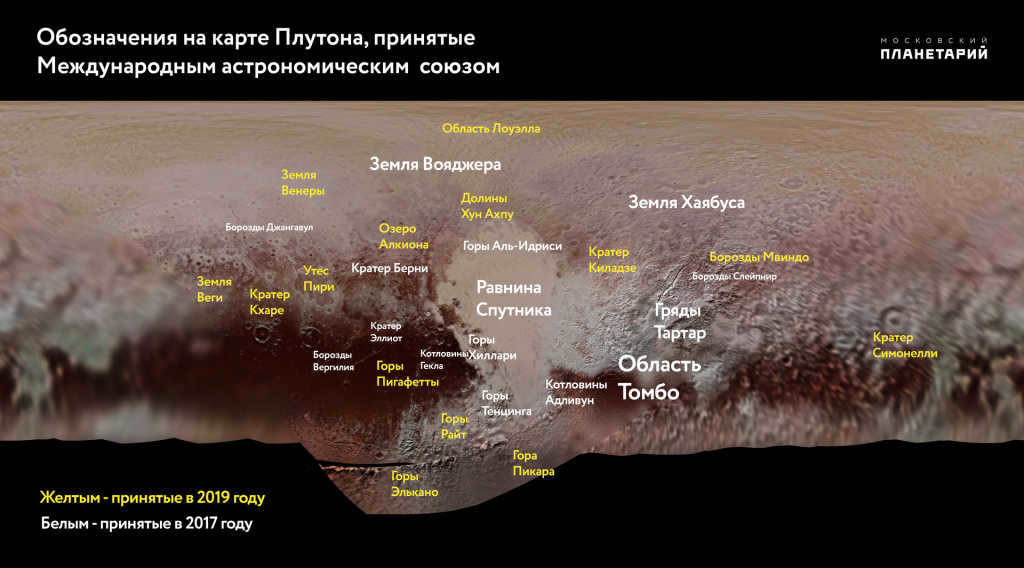
14 designations for the new surface of Pluto were adopted by the IAU in 2019:
- Lake Alcyone – named after the mysterious lake near Lerna, which was believed to be an entrance to the underworld according to Greek mythology.
- Elcano Mountains – named in honor of Juan Sebastian Elcano, the navigator who took part in the first circumnavigation of the world.
- The Hun Ahpu Valleys – named after one of the heroic twins in Mayan mythology who defeated the gods of the underworld in a ball game.
- The Khare Crater – named after planetologist Bishun Khare, who extensively studied tholin, an organic matter responsible for the colorful regions on Pluto.
- Kiladze Crater – named after astronomer Rolan Kiladze, who was the first to conduct photometric and astrometric observations of Pluto, as well as research on its dynamics.
- The Lowell region – named after astronomer Percival Lowell, who organized the systematic search for a planet beyond Neptune, which ultimately led to the discovery of Pluto.
- Mvindo’s Furrows – named after the legendary hero of the Nyanga people’s folklore, who ventured into the underworld and emerged as a wise and powerful king upon his return.
- Mount Picara – named in honor of Auguste Picard, an inventor and physicist renowned for his balloon flights into the Earth’s upper atmosphere.
- The Pigafetta Mountains – named after Antonio Pigafetta, a scientist and historian who participated in the first-ever circumnavigation of the globe.
- The Piri Utes – named after the Ottoman cartographer and navigator Ahmed Muhyiddin Piri, who created some of the earliest maps of North and Central America, as well as the world.
- Simonelli Crater – named after astronomer Damon Simonelli, whose work focused on the formation of Pluto.
- The Wright Mountains – named in honor of the Wright brothers, who are credited with pioneering the design and construction of the world’s first airplane.
- Vega Land – named after the Project Vega interplanetary vehicles that explored Venus and Halley’s Comet.
- Venus Land – named after the vehicles of the Venus interplanetary program, which made the first soft landing on the second planet from the Sun.
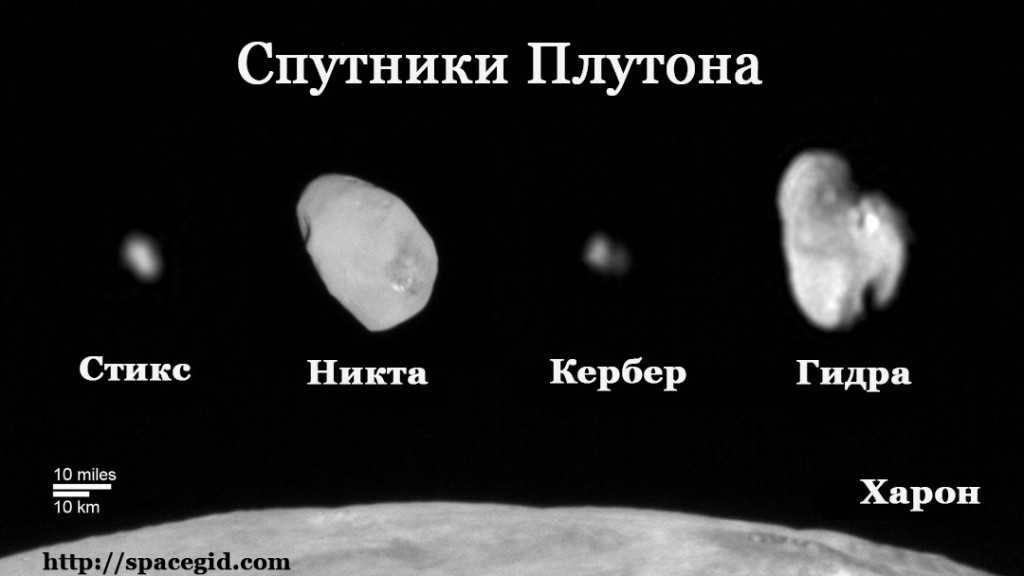

In 1930, when Pluto was first discovered, scientists believed it was a solitary planet orbiting the Sun. However, almost half a century later, astronomers made an astonishing discovery: Pluto has a large satellite known as Charon.
Fast forward to 2005, astronomers using the Hubble Space Telescope made another breakthrough. They announced the existence of two additional moons, officially named Nix and Hydra. Then, in 2011 and 2012, the fourth and fifth satellites were spotted, respectively.
Astronomers have recently determined that the planet has just five satellites.
The initial and most substantial one is Charon, which was discovered in 1978 by astronomer James Christie. He made this groundbreaking observation by identifying a protrusion on one side of Pluto in a photograph.
Additional Resources
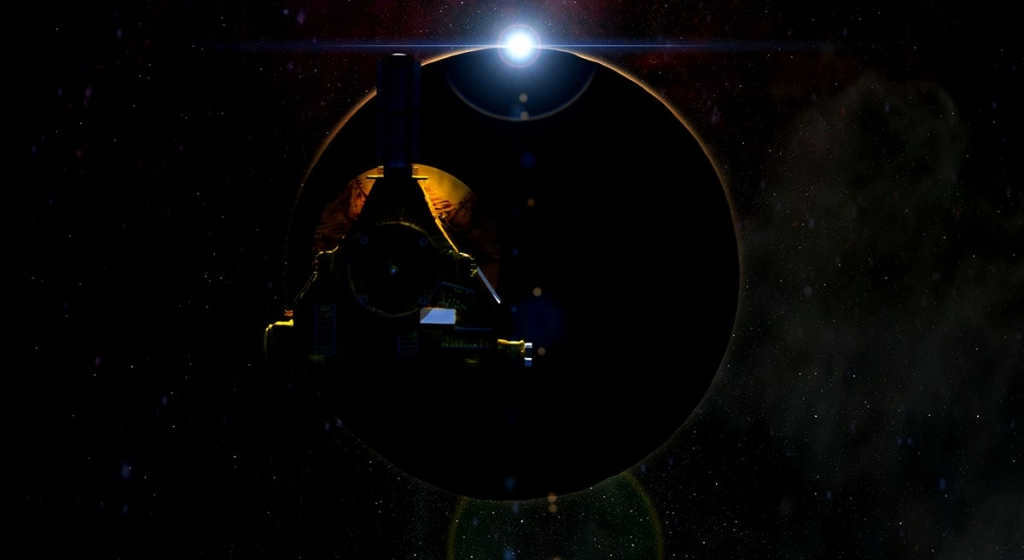
In the beginning, Christy and his colleagues initially believed that this bulge was a flaw in the telescope, however, they soon realized that only it was elongated while the backdrop of stars remained unchanged. The scientist came to the realization that he was observing one of Pluto’s moons.
The moon was bestowed the name Charon, after the ferryman from Greek mythology who transported deceased souls across the sacred river Styx.
In terms of size, Charon is significantly large and massive. To put it into perspective, Pluto measures 2306 kilometers in diameter while Charon measures 1205 kilometers.
An intriguing fact is that Pluto and Charon actually constitute a binary system. These two celestial bodies revolve around a shared center of mass, which is located outside the surface of the dwarf planet. In contrast, the Earth and Moon possess a center of gravity situated within the Earth.
Nix has a diameter of 46 kilometers, while Hydra measures 61 kilometers across. In 2011, a fourth satellite was found, which has a diameter of 34 kilometers, and in 2012, a fifth satellite was discovered with a diameter of only 25 km.
The New Horizons Mission
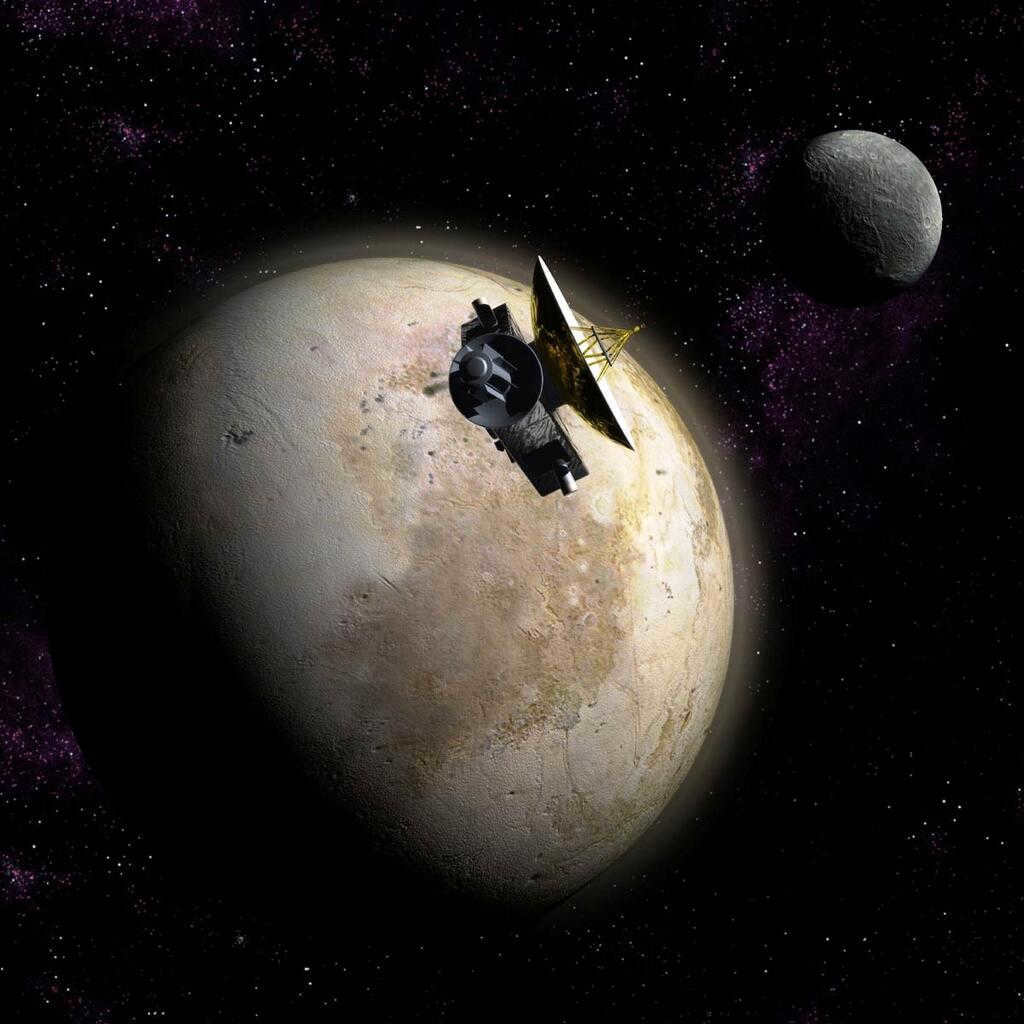
New Horizons spacecraft is expected to reach Pluto in 2015, providing us with an opportunity to gain more knowledge about the dwarf planet and its moons. The recent discovery of these moons has sparked hope in the scientific community, as it suggests the possibility of a ring system around Pluto. This ring system could have been formed by micrometeorites colliding with the surface of the dwarf planet. Another theory proposes that Charon, one of Pluto’s moons, produces ice similar to Enceladus. The upcoming close encounter of New Horizons with Pluto’s surface, within a distance of 10,000 kilometers, will allow us to capture high-quality images like never before.
In 2015, if everything goes as planned, we will finally have the chance to witness the true appearance of it. We will have a remarkable opportunity to observe it simultaneously with all the satellites.
Description of Pluto’s satellites – a detailed account of the five satellites orbiting the dwarf planet, including photos, intriguing facts, characteristics, and sizes: Charon, Nycta, Styx, Kerber, and Hydra.
To introduce children to this topic, it is important to first explain that they are about to learn about a former ninth planet that is now classified as a dwarf planet. Now, let’s answer the question: how many satellites does Pluto have? Well, this unique world has a total of five satellites, each varying in size. Additionally, teachers and parents might notice that some of these satellites have rather peculiar orbits, which scientists refer to as pandemonium.
Charon: Pluto’s Largest Moon
Did you know that Pluto has a moon that is incredibly large and is only half the size of the planet itself? This moon, discovered in 1978 and named Charon, has a diameter of 1200 km (compared to Pluto’s 2370 km). According to ancient Greek mythology, Charon is a demon who transports deceased souls to the underworld (which is where the name Pluto, the god of the underworld, comes from). The size of Charon has led some scientists to consider it as a possible double dwarf planet or a double system.
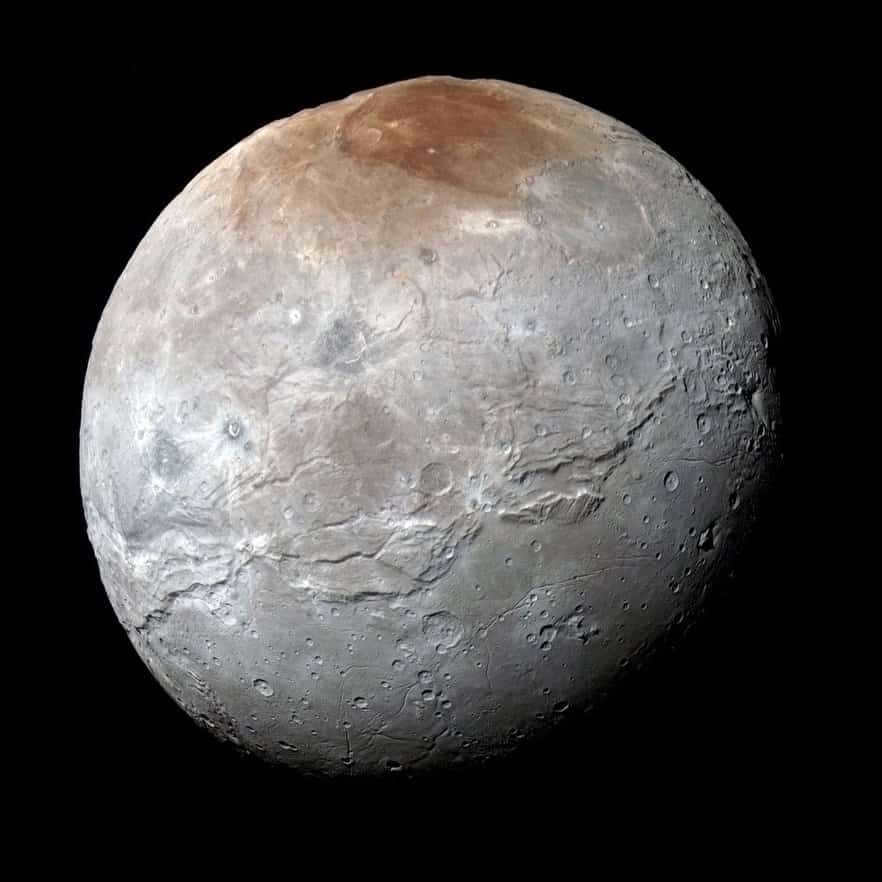

The photo was taken by the New Horizons spacecraft shortly before it arrived on July 14, 2015.
They are located 19640 kilometers apart, which is even less than the distance between London, England and Sydney, Australia. The satellite completes one orbit around Pluto in 6.4 days, which is the same amount of time it takes for Pluto to make one rotation on its axis. It is important to explain to children that Charon always stays above a specific area on Pluto, so they are always facing each other on the same side. This phenomenon is known as tidal locking.
Despite its gray color, the satellite displays a reddish hue at its northern pole. While most of its surface is covered in water ice, the red area is likely composed of crushed atmospheric particles. Being a young moon, there are speculations of a previously existing ocean that has since frozen over.
Youngsters should appreciate the uniqueness of this system, as it is tilted in its own axis in relation to its star. Furthermore, Pluto rotates in the opposite direction – from east to west (retrograde rotation).
Pluto’s two smaller moons – a children’s guide
Back in 2005, scientists made use of the incredible Hubble Space Telescope to capture images of Pluto as part of the preparations for the New Horizons mission. This groundbreaking mission marked the first time a spacecraft had ever ventured to Pluto and the Kuiper belt. During this monumental moment, the researchers were able to discover two minuscule moons known as Nycta and Hydra. These two satellites can be found at a distance two to three times greater than that of Charon, Pluto’s largest moon.
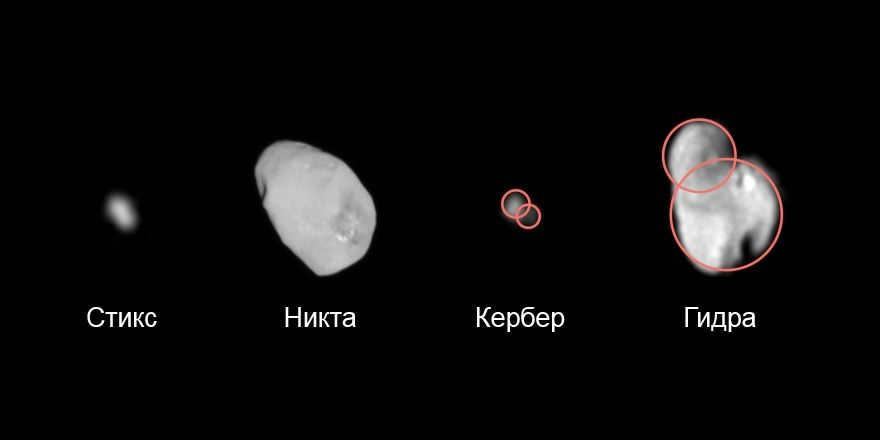

This is a detailed view of the four smaller moons of Pluto that were discovered by the New Horizons spacecraft in July 2015. It is possible that two or even four of these moons formed through the merging of smaller moonlets.
While a significant amount of information has been gathered about Charon, there is only limited data available about these moonlets, as they were observed by the instrument from a distance of 3 km (Nicta) and 1.2 km (Hydra). Nicta has a length of 42 km and a width of 36 km, while Hydra measures 55 km in length.
If we take a look at the structure of Hydra, it bears a striking resemblance to an onion with two massive cavities. It shares many similarities with comet 67P/Churyumov-Gerasimenko (which was investigated by the European Rosetta mission in August 2014). Scientists speculate that Hydra formed as a result of the merging of these two entities and believe that similar events could occur again in the case of Hydra.
Parents or teachers can educate children about Hydra, a mythical creature from ancient Greek mythology. Hydra was a fearsome serpent with nine heads that served as a guardian in the kingdom of Pluto. On the other hand, Nix is an interesting moon shaped like a jellybean with a large crater. It is brighter than Charon, another moon of Pluto, but not as bright as Pluto itself. According to Greek myths, Nix was the goddess of night and the mother of Charon. What’s remarkable about Nix is its deep crater, which may have caused the moon to fragment. This means that Nix could either be extremely fortunate or a fragment of an ancient moon. All four satellites, including Hydra and Nix, appear to be composed mainly of pure water ice.
In 2011, Hubble utilized its capabilities to locate the fourth moon, Kerber. This discovery is especially captivating for young individuals, as Kerber possesses a unique characteristic of having two lobes, with diameters measuring 8 km and 5 km respectively. It is hypothesized that this moon may have come into existence as a result of the merger of two celestial bodies.
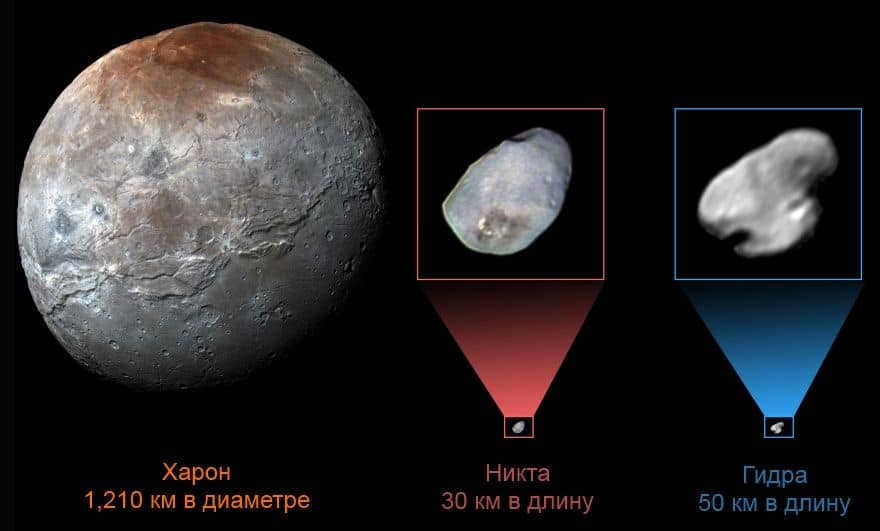
Comparison of the sizes of Charon, Nycta, and Hydra
Kerber orbits around Nycta and Hydra, exerting a strong influence on its neighboring satellite despite its relatively small size. Prior to the spacecraft’s arrival, scientists believed this moon to be large and dark, but it was discovered to be tiny and bright. It was named after Cerberus, a Roman mythological dog with three heads.
The fifth satellite, Styx, was discovered in 2012. It has an irregular shape and a width of 7 kilometers. It orbits around a dwarf with a diameter of 95,000 km.
We hope that you had a great time reading about the fascinating story and description of Pluto’s 5 satellites. When explaining this to children, it’s important to incorporate interesting facts, captivating photos, engaging videos, and visually appealing illustrations to enhance their learning experience. Your child will also be amazed by our interactive 3D model of the solar system, which includes a detailed map of the dwarf planet Pluto and a captivating view of its satellites. Unfortunately, these moons cannot be observed in real time through an online telescope due to their small size. However, it’s worth mentioning that Charon is particularly interesting to search for.
Pluto is renowned as the largest known dwarf planet in our Solar System. It is classified as a trans-Neptunian object and ranks as the tenth most massive celestial body in orbit around the Sun, excluding satellites. This places it after the eight planets and Eridas. Initially, Pluto was considered the ninth classical planet, but its classification changed in 2006 when it was redefined as a dwarf planet. It currently holds the title as the largest object in the Kuiper belt.
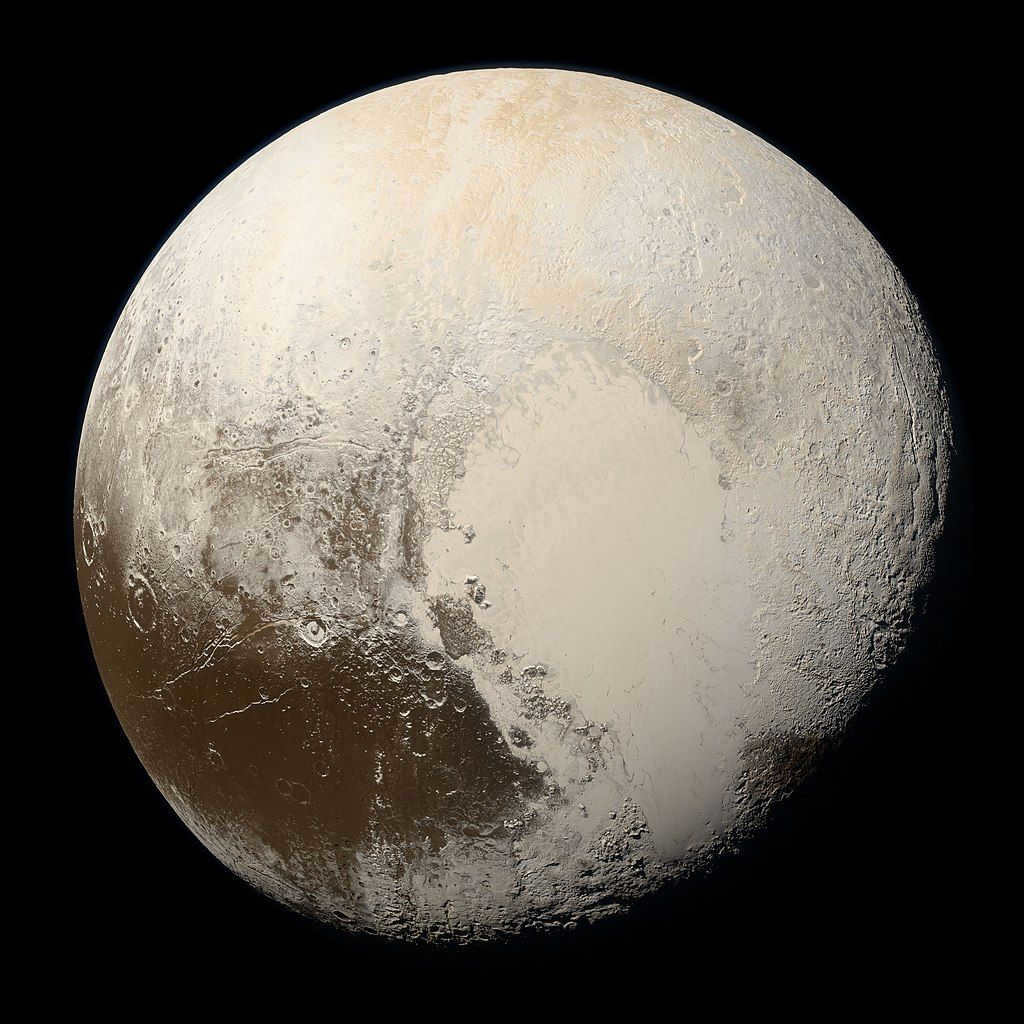
Similar to the majority of Kuiper Belt objects, Pluto is primarily made up of a combination of rock and ice and is relatively small in size. In fact, it has a mass that is approximately six times smaller than that of the Moon, and its volume is about three times smaller. Interestingly, the total area of Pluto (17.7 million km²) is slightly larger than Russia’s (17.1 million km²). Additionally, Pluto has an orbit with a significant eccentricity and inclination in relation to the ecliptic plane.
Because of the unique shape of its orbit, Pluto is currently getting closer to the Sun, at a distance of 29.7 astronomical units (4.4 billion kilometers), making it closer than Neptune, and then moving away at 49.3 astronomical units (7.4 billion kilometers). Pluto and its largest companion, Charon, which was discovered in 1978, are often considered a binary system because the center of mass of their system is located outside of both objects. The International Astronomical Union (IAU) has expressed its intention to establish a formal definition for binary dwarf planets, and until then, Charon is classified as a satellite of Pluto. In addition to Charon, Pluto has four other smaller satellites:
1) Nicta and Hydra, which were discovered in 2005;
2) Kerber, which was first announced on July 20, 2011;
3) Styx, whose discovery was announced on July 11, 2012.
Pluto’s system has been previously examined by terrestrial and near-Earth astronomical devices, and in 2015, it was investigated from a short distance by the U.S. spacecraft New Horizons, which was launched during a time when Pluto was still regarded as a typical planet.
The element plutonium was named after Pluto:393.
Pluto’s Orbit and Rotation
Pluto has a unique orbit compared to the other planets in our solar system. Its eccentricity is much higher at 0.2488, and it has an inclination of 17.14 degrees to the ecliptic plane. The major semi-axis of Pluto’s orbit measures 5.906 billion km or 39.482 a.u. However, due to its significant eccentricity, Pluto’s distance from the Sun varies greatly. At its closest point to the Sun, called perihelion, Pluto is 4.437 billion km away. At its farthest point, known as aphelion, Pluto is 7.376 billion km from the Sun. This equates to a range of 29.7-49.3 a.u. In terms of travel time for light, it takes approximately 247 minutes for light (including radio waves) to travel from the Sun to Pluto at perihelion. However, at aphelion, this time increases to 410 minutes. The light intensity also differs significantly, with a factor of 2.8 between perihelion and aphelion. Interestingly, when Pluto is in opposition, the signal from Earth reaches it 8 minutes faster compared to when it is in square.
The orbit of Pluto has a high eccentricity, which means that part of its orbit brings it closer to the Sun than Neptune. This happens periodically, with the last occurrence being from February 7, 1979, to February 11, 1999. According to calculations, this position was also observed from July 11, 1735, to September 15, 1749, for a total of 14 years. Even further back in history, from April 30, 1483, to July 23, 1503, Pluto occupied this position for a total of 20 years.
One interesting fact about Pluto’s orbit is its inclination to the ecliptic plane, which is why it does not intersect with Neptune’s orbit. When Pluto reaches its closest point to the Sun (perihelion), it is about 10 astronomical units (a.u.) above the ecliptic plane. It is worth noting that Pluto’s orbital period is 247.92 Earth years, which means it takes almost 248 years for Pluto to complete one orbit around the Sun. In comparison, Neptune takes about 165 years to complete three orbits during the same time period.
Because of these differences in orbital periods and inclinations, Pluto and Neptune are never closer to each other than about 17 a.u.
Pluto’s trajectory can be anticipated for numerous million years in both directions, but beyond that, its path becomes unpredictable. The movement of Pluto is disorderly and can only be described using nonlinear equations. However, one must observe it for a considerable amount of time to notice this chaos. There is a specific timeframe for its progression, known as the Lyapunov time, which is approximately 10-20 million years for Pluto. If we examine its motion in short intervals, it may appear to follow a regular pattern (periodic elliptical orbit). Nevertheless, in reality, the orbit undergoes slight shifts with each cycle, eventually deviating so much that no traces of the original orbit remain. Consequently, it is incredibly challenging to model Pluto’s movement for distant points in time.
Pluto and Neptune’s Orbital Paths
Neptune and Pluto are locked in a unique dance in space, where Neptune completes three orbits around the Sun for every two orbits of Pluto. This intricate celestial choreography takes approximately 495 years to complete.
The intersection of Pluto’s orbit with the ecliptic plane coincides with the intersection of Neptune’s orbit, indicating that there are times when Pluto comes into close proximity with Neptune. However, it is paradoxical that there are also times when Pluto is closer to Uranus. This can be explained by the phenomenon of resonance. In each cycle, when Pluto reaches its closest point to the Sun (perihelion) for the first time, Neptune is ahead of Pluto (for example, at perihelion on September 5, 1989, at an angle of 57°). When Pluto reaches perihelion for the second time, Neptune has completed one and a half revolutions around the Sun and is behind Pluto (at perihelion on September 16, 2237 – at an angle of 120°). At the moment when Neptune and Pluto are aligned with the Sun and on the same side of it, Pluto reaches its farthest point from the Sun (aphelion).
Therefore, Pluto is never closer to Neptune than 17 astronomical units (a.u.), but it can come as close as 11 a.u. to Uranus.
The stable interdependence of the orbits provides evidence contradicting the idea that Pluto was once a moon of Neptune and later left its system. However, it raises the question: if Pluto never came close to Neptune, how could a dwarf planet significantly less massive than the Moon, for instance, have achieved resonance? One hypothesis proposes that if Pluto was not initially in resonance with Neptune, it may have periodically approached Neptune much more closely, and these close encounters over billions of years influenced Pluto, leading to the alteration of its orbit into its current observed state.
Physical features
Pluto is a challenging subject for study due to its considerable distance from Earth. Our understanding of this celestial body was limited until 2015, when the New Horizons spacecraft conducted a flyby mission.
Appearance and composition
Due to its considerable distance from Earth, exploring Pluto is a challenging task. It wasn’t until 2015 that the New Horizons spacecraft flew by, shedding light on many unknown aspects of the dwarf planet. With an average sidereal magnitude of 15.1 (reaching 13.65 at perihelion), observing Pluto requires a telescope, preferably with a minimum aperture of 30 cm. Even with large telescopes, Pluto appears as a mere dot, indistinguishable from an ordinary star, as its angular diameter does not exceed 0.11″. Its color is described as light brown. Unfortunately, the distance to Pluto and the limitations of current telescopes make it difficult to obtain high-quality images of its surface. The Hubble Space Telescope’s photographs only reveal basic details of its albedo. The initial maps of Pluto were created using brightness observations during eclipses by its moon Charon between 1985 and 1990. This method relies on the fact that an eclipse of a bright area results in a greater decrease in apparent brightness compared to an eclipse of a dark area. By analyzing the changes in brightness during eclipses, it becomes possible to map the albedo of the hemisphere of Pluto that faces Charon. However, these maps only display the primary features of the albedo, including a discontinuous dark band located south of the equator.
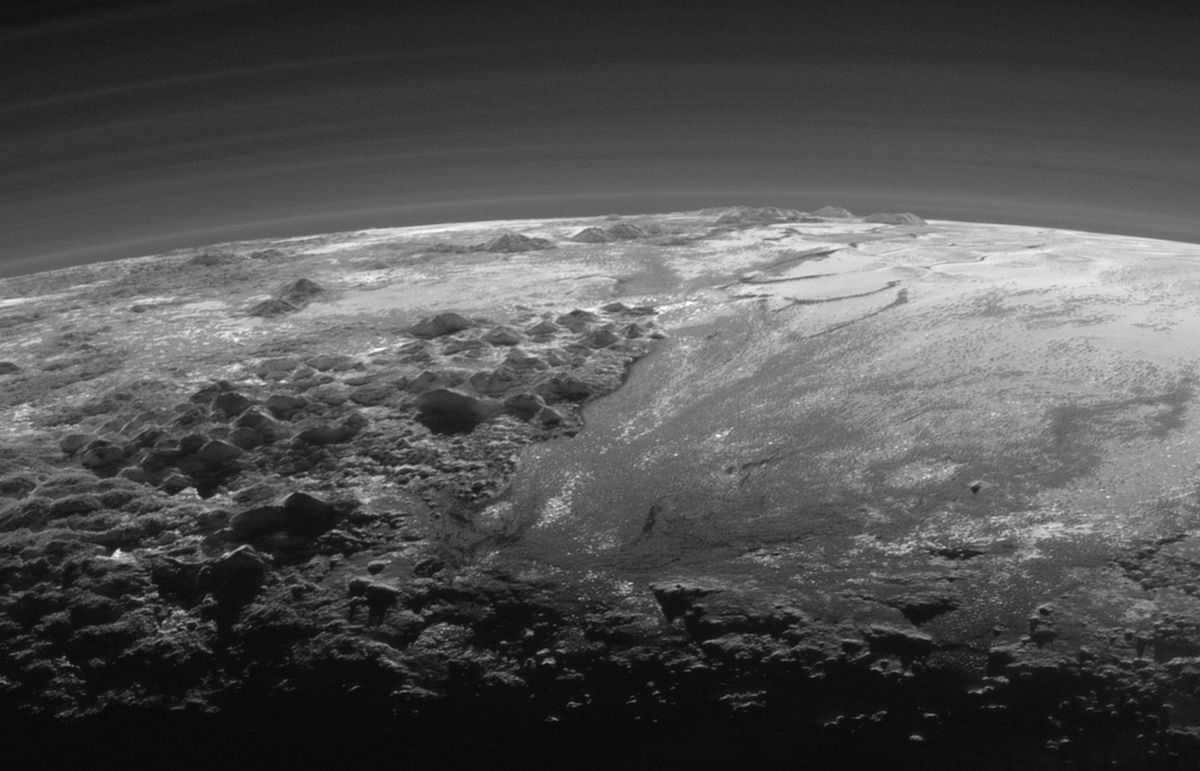
Pluto’s surface displays a remarkable level of diversity. This fact is readily apparent in imagery captured by the Hubble telescope, and has been further confirmed by the New Horizons probe, which provided even more detailed photographs. The reflectivity of different regions on Pluto’s surface varies significantly, ranging from 10% to 70%. As a result, Pluto is the second most contrasting celestial body in our solar system, surpassed only by Japet. This stark contrast in reflectivity leads to periodic changes in the amount of light emitted by Pluto (with variability reaching as high as 30%) as well as changes in its spectrum. The variations in spectrum have allowed scientists to determine that nitrogen and carbon monoxide are more prevalent on the side of Pluto facing away from Charon (located at 180° E, where Pluto’s “heart” is situated), while methane is most abundant in the vicinity of 300° E. The highest concentrations of methane can be found in the immediate vicinity of Pluto itself.
Pluto’s density is approximately 1.860 ± 0.013 g/cm3. The composition of its interior is likely a combination of 50-70% rock and 50-30% ice, predominantly water ice. Various forms of ice, including ice I, ice II, ice III, ice V, and ice VI, can exist within its interior. If the heat generated by the decay of radioactive elements was sufficient to separate the ice from the rock, then Pluto’s interior would be differentiated, with a dense rocky core surrounded by a mantle of ice that is approximately 300 km thick. It is conceivable that this heat could have also led to the presence of liquid water beneath the surface. The subsequent freezing of this water could have resulted in the formation of surface features such as grabens and scarps.
Spectral data reveals the presence of water ice on the surface of Pluto, although it is predominantly concealed by a layer of more easily vaporized ice, primarily nitrogen ice (97-98%). Additionally, traces of frozen methane (approximately 1.5% or 3%, depending on different estimates) and carbon monoxide (0.01% or 0.5%) have been detected, along with impurities from other compounds (mainly derived from methane and nitrogen due to intense radiation exposure). These impurities include ethane and potentially more complex hydrocarbons or nitriles, as well as tholins, which contribute to Pluto’s brownish hue (as well as the coloring of other celestial bodies located far from the Sun). Notably, nitrogen, carbon monoxide, and to a lesser extent, methane, exhibit significant volatility within Pluto’s environment, allowing for seasonal movement across its surface.
In 2015, the AMS New Horizons captured images of Pluto that unveiled an expansive bright zone in the shape of a heart symbol, measuring 1800×1500 km. Additionally, the equatorial zone showcased towering mountains reaching heights of 3.5 kilometers, believed to be composed primarily of water ice. These mountains sharply contrasted with the generally smooth icy surface of the planet. The images also revealed numerous other distinctive surface features. At this time, the surface features have been assigned temporary names; however, these names are still pending approval from the IAU Planetary System Nomenclature Working Group and are therefore subject to change.
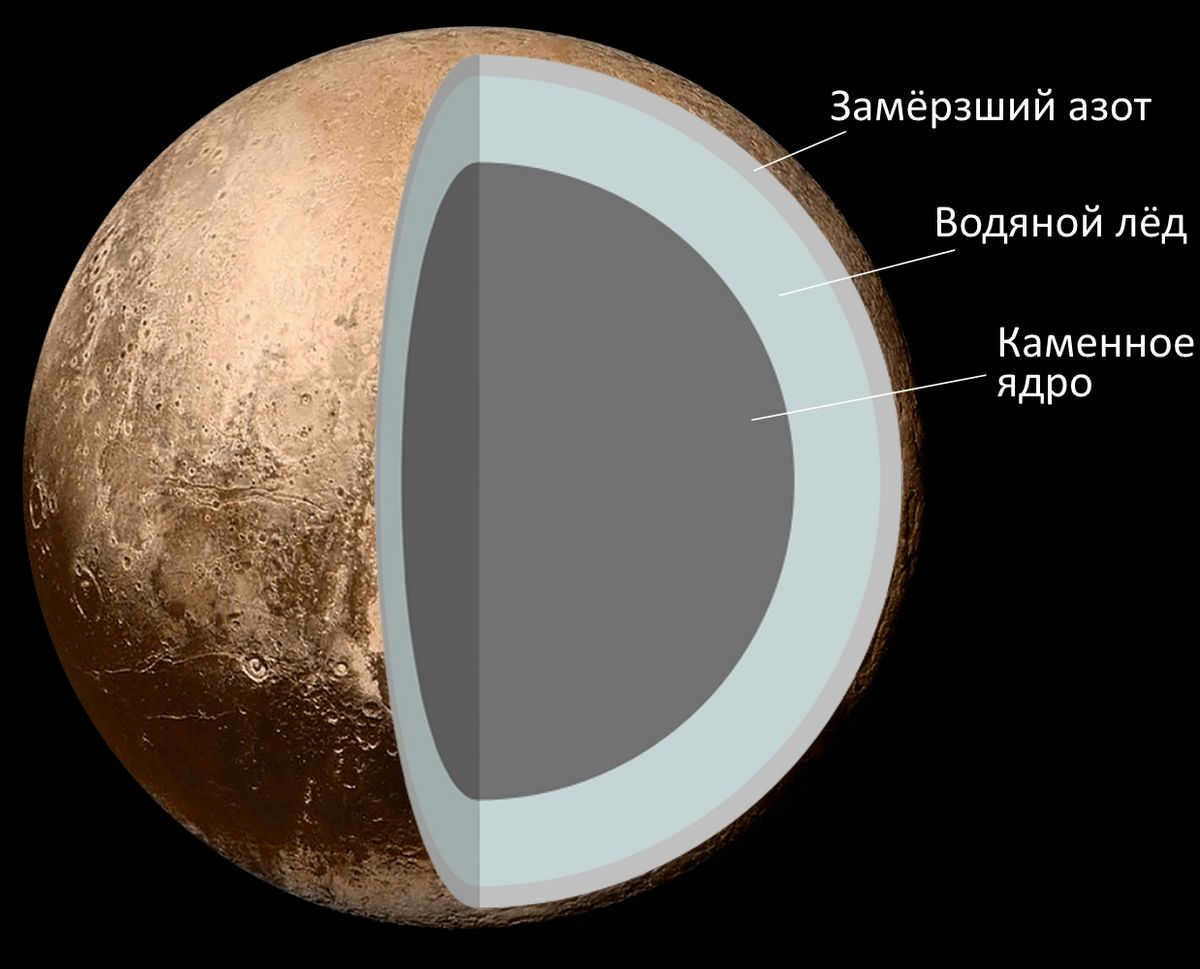
The International Astronomical Union approved six themes in February 2017 for naming details of Pluto’s surface. These themes include gods, goddesses, and other beings associated with the underworld in mythology, folklore, and literature; names of underworld locations in mythology, folklore, and literature; heroes and explorers of the underworld; scientists and engineers associated with Pluto and the Kuiper Belt; pioneering space missions and spacecraft; and historical pioneers who explored new horizons on Earth, sea, and sky.
Pluto does not possess a significant magnetic field. Based on its interaction with the solar wind, the magnetic induction at its surface cannot exceed 30 nTL, which is 2000 times lower than that of Earth.
Mass and Size
In the beginning, astronomers attempted to determine the mass of Pluto by studying its impact on the orbits of Neptune and Uranus, believing it to be the same “Planet X” as proposed by Lowell. In 1915, Lowell himself predicted a mass equivalent to 6.6 times that of Earth. By 1931, it was believed that Pluto’s mass was similar to that of Earth, but subsequent calculations in 1971 estimated it to be about the same as Mars (this same estimate was also obtained in 1950 when attempting to measure its angular diameter). In 1976, astronomers from the University of Hawaii discovered evidence of methane ice in Pluto’s spectrum, indicating a high albedo. This suggested that Pluto was relatively small in size and therefore had a mass that was only a fraction of Earth’s.
The identification of Charon, Pluto’s satellite, in 1978 enabled scientists to calculate the combined mass of the two celestial bodies utilizing Kepler’s third law. Subsequent investigations permitted the determination of the individual masses of Pluto and Charon. Currently, Pluto’s mass is estimated to be (1.303 ± 0.003)⋅1022 kg, equivalent to 0.22% of Earth’s mass.
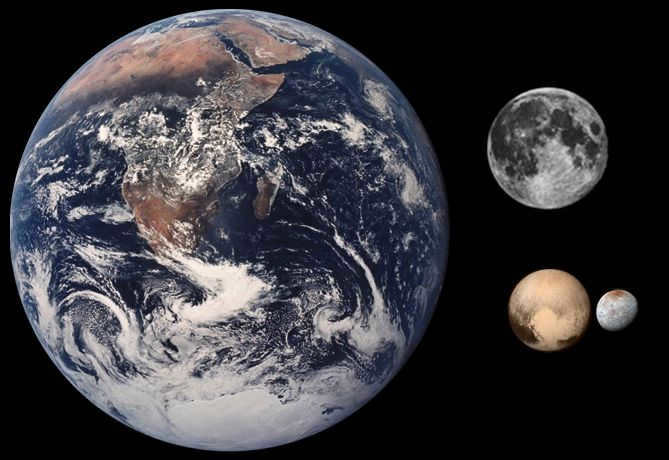
Pluto, while smaller in size and mass than the larger planets of our Solar System, is also smaller than several of their satellites. It is smaller than seven satellites: Ganymede, Titan, Callisto, Io, the Moon, Europa, and Triton. The mass of Pluto is nearly six times less than that of the Moon (and 480 times less than that of the Earth), and its diameter is two-thirds the diameter of our natural satellite. However, Pluto is 2.5 times larger and 14 times more massive than Ceres, the largest object in the asteroid belt. Among the known trans-Neptunian objects, Pluto has the largest diameter, but it is only a quarter of the mass of the dwarf planet Eridus from the scattered disk.
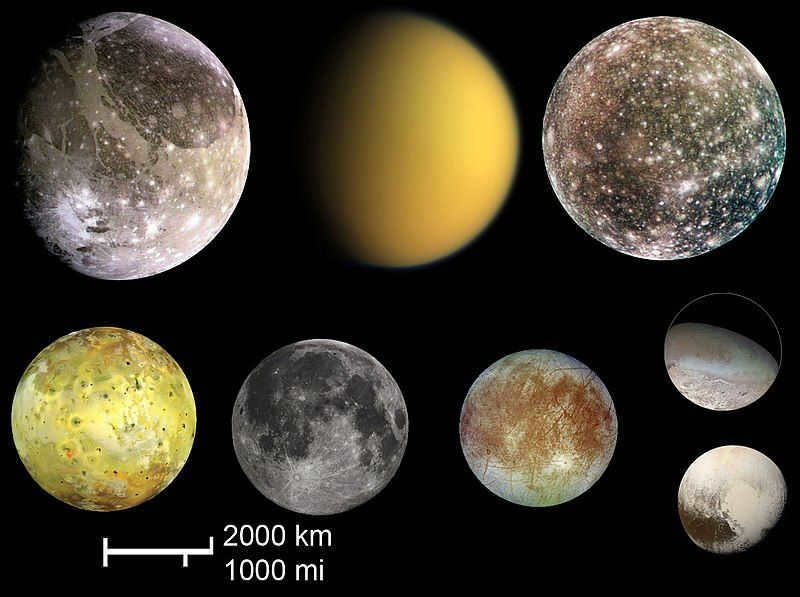
Satellites of Pluto
Pluto possesses a total of five known natural satellites, with one of them being significantly larger than the rest. The discovery of Charon, the largest satellite, took place in 1978 by James Christie, while the others were later found using the Hubble telescope. Nikta and Hydra were both discovered in 2005, Kerberus in 2011, and Styx in 2012. All of these satellites have nearly circular orbits and are situated approximately in the equatorial plane of Pluto, moving in the same direction as its axis rotation.
The satellite closest to Pluto is Charon, followed by Styx, Nycta, Kerberus, and Hydra. These satellites exhibit a close orbital resonance, with their periods being in a ratio of 1:3:4:5:6. Additionally, Styx, Nicta, and Hydra are in resonance with a period ratio of 18:22:33.
Charon and Pluto rotate together, but the rest of the moons have different rotation periods and tilted axes compared to Pluto and Charon.
All four of Pluto’s small moons have irregular shapes and surprisingly high brightness (with a geometric albedo of about 0.6, and Hydra even has 0.8). This is much higher than Charon’s brightness (0.38) and most other small objects in the Kuiper belt (around 0.1). It is likely that these moons are covered in relatively pure water ice.
By studying the Pluto system with New Horizons, we were able to determine the maximum size of undiscovered moons. It was observed that there are no moons larger than 4.5 km within a distance of 180,000 km from Pluto (and even smaller for closer distances). This calculation assumes an albedo of 0.38, similar to that of Charon.
The identification of tiny moons orbiting Pluto has led to the hypothesis that a ring system may exist, formed by the debris from meteorite impacts on these moons. However, both the Hubble and New Horizons observations have failed to provide any conclusive evidence of the existence of rings. If they do exist, they must be incredibly sparse, with a geometric albedo of no more than 1.0×10-7.
Origin and location within the Solar System
The origins of Pluto and its position in the classification of celestial bodies in the solar system have long been a source of intrigue. In 1936, British astronomer Raymond Littleton proposed the theory that Pluto was a satellite that had “escaped” from Neptune, possibly due to a collision with Neptune’s largest moon, Triton. However, this hypothesis has faced substantial criticism, as Pluto’s orbit never brings it close to Neptune.
However, starting in 1992, astronomers began discovering numerous small icy objects beyond Neptune’s orbit that shared similarities with Pluto, both in terms of their orbit and their size and composition. This region of the outer solar system was subsequently named the Kuiper Belt, after astronomer Gerard Kuiper, who suggested that it was the source of short-period comets. As of July 2015, Pluto is the largest known object in the Kuiper Belt. Like comets, Pluto’s atmosphere is affected by the solar wind, which blows gases away from its surface. If Pluto were located as close to the Sun as Earth, it would likely develop a comet tail.
Neptune’s moon Triton, which is slightly larger than Pluto, shares a similar composition (although it differs significantly in terms of geological characteristics) and is believed to have been captured from the same region of the Kuiper Belt. Erida, a celestial body only slightly smaller than Pluto, is not considered part of the Kuiper Belt and is likely part of the scattered disk. There are also a significant number of objects in the Kuiper Belt, like Pluto, that have a 3:2 orbital resonance with Neptune and are known as “plutinos.”
The International Astronomical Union officially recognized Pluto as a planet in May 1930, at a time when scientists believed it to be similar in size to Earth. However, the classification of Pluto as a planet has been a subject of debate since 1992, when the first Kuiper Belt object, known as (15760) 1992 QB1, was discovered. The discovery of additional objects in the Kuiper Belt further fueled the controversy surrounding Pluto’s status. Ultimately, on August 24, 2006, Pluto was reclassified as a dwarf planet.
Pluto’s Status as a Planet
Pluto’s classification as a planet was acknowledged in the plaques that accompanied the Pioneer 10 and Pioneer 11 space probes in the early 1970s. These plates, made of anodized aluminum, were sent along with the instruments into deep space in the hopes that they would be found by extraterrestrial beings, providing them with information about the nine planets in our solar system. Similar information about Pluto as the ninth planet was also included in the messages sent with Voyager 1 and Voyager 2 during the same period. Interestingly, there is a popular theory that suggests that Pluto, the beloved dog character from Disney cartoons, was named after the planet in honor of its discovery, as the character made its debut on screens just six months after Pluto’s official identification.
Glenn Seaborg gave the name plutonium to the recently formed element in 1943, in accordance with the customary practice of naming new elements after newly found celestial bodies: neptunium after Neptune, uranium after Uranus, and cerium and palladium after the planets Ceres and Palladus, which were initially believed to be planets.
The discussion of the 2000s
In the year 2002, Kvavar was found in the region beyond Neptune’s orbit. It has a diameter of approximately 1110 km based on current data. Likewise, in 2004, Sedna was discovered, which has a diameter of about 1000 km. These two objects are comparable in size to Pluto, which measures 2376.6 km. Similar to Ceres losing its classification as a planet after the identification of other asteroids, the status of Pluto had to be reevaluated due to the discovery of similar celestial bodies.
The International Astronomical Union’s decision to redefine the classification of Pluto
In 2006, the International Astronomical Union made a definitive ruling on the status of Pluto by officially establishing the criteria for classifying an object as a “planet” within the Solar System. The following conditions must be met for an object to be considered a planet:
1) It must orbit the Sun and be a satellite of our star, rather than one of the planets.
2) It must have enough mass to achieve a hydrostatic equilibrium shape, resembling a sphere, due to the influence of its gravitational forces.
3) It must have cleared the area around its orbit of other bodies of comparable size, demonstrating gravitational dominance, with the exception of its own satellites or those under its gravitational influence.
Pluto fails to meet the third requirement because its mass is only 7% of the total mass of all objects in the Kuiper Belt. In contrast, the Earth has a mass 1.7 million times greater than all other objects in its orbit. To address this, the International Astronomical Union (IAU) assigned Pluto to two new categories: dwarf planets and, as a prototype, to the group of trans-Neptunian objects known as “plutoids”. On September 7, 2006, the IAU officially listed Pluto as a minor planet with the designation 134340. If Pluto had been recognized as a minor planet immediately upon its discovery, it would have been one of the first thousand to receive a number. The first minor planet discovered after Pluto was (1164) Kobold, found a month later. This means that Pluto could have been given the number 1164. The reclassification of Pluto was met with resistance in the astronomical community. Alan Stern, the lead researcher of NASA’s New Horizons mission, openly criticized the IAU’s decision, claiming that the definition was meaningless and that even Earth, Mars, Jupiter, and Neptune did not meet it, as they share their orbits with asteroids. He also argued that since less than 5% of astronomers voted on the decision, it cannot be considered the consensus of the entire astronomical community. Other astronomers, such as Mark Bouyer of Lowell Observatory, also disagreed with the new planet definition. However, Michael Brown, the astronomer who discovered Erida, supported the IAU’s decision, stating, “Despite the chaotic nature of the process, we have somehow arrived at an answer. It took a while, but eventually the science will self-correct, even amidst strong emotions in the debate.”
There were various reactions from the general public when Pluto lost its status as a planet. While most people accepted the decision quietly, others took more active measures. Some individuals went online to petition the International Astronomical Union (IAU), while others organized rallies and street actions with slogans like “Save Pluto!” in an attempt to convince astronomers to reconsider. In California, a group of state legislature members introduced a draft resolution condemning the IAU’s decision, labeling it as scientific heresy. Meanwhile, the legislatures of Illinois and New Mexico, where Clyde Tombaugh (the discoverer of Pluto) was born and lived, declared that Pluto would always be recognized as a planet in their states as a tribute to him. Many people refused to accept the IAU’s decision for sentimental reasons, as they had known Pluto as a planet throughout their lives and intended to continue doing so regardless of the IAU’s rulings. Polls conducted among Americans revealed that a significant number of them also opposed the decision, largely because Pluto had been the only planet discovered by an American until its reclassification.
On June 11, 2008, the International Astronomical Union (IAU) made an important announcement regarding the categorization of celestial bodies. They introduced a new concept called a “plutoid.” The IAU designated the dwarf planets Pluto, Erida, Makemake, and Haumea as plutoids. However, it is important to note that the dwarf planet Ceres does not fall under this category.
What lies ahead for the Pluto system
Based on the current understanding of stellar evolution, it is predicted that the luminosity of the Sun will gradually increase as time goes on. In approximately 1.1 billion years, it is estimated that the Sun will be approximately 11% brighter than its current state. This increase in luminosity will have significant effects on the habitable zone of the Solar System, causing it to shift outward beyond Earth’s current orbit. Eventually, the habitable zone will extend to encompass Mars, Jupiter, and then Saturn.
Looking further ahead, in approximately 7.6-7.8 billion years, the Sun’s core will reach a temperature that will initiate the process of hydrogen burning in the surrounding shell. This will result in a dramatic expansion of the outer layers of the Sun, transforming it into a red giant. During this phase, it is conceivable that the conditions necessary for life to develop could exist on Pluto and other objects in the Kuiper Belt. Pluto may be able to sustain these conditions for tens of millions of years, until the Sun eventually evolves into a white dwarf and eventually ceases to emit light.
Back in 1978, scientists made an incredible discovery – they found one of Pluto’s moons, Charon. Interestingly, Charon is much lighter than Pluto, weighing only 8 times less. However, what’s even more fascinating is that Charon doesn’t orbit around Pluto like a typical moon would. Instead, both Pluto and Charon revolve around a central point of mass. This unique dynamic adds to the complexity of Pluto’s situation. To make matters worse, in 2005, another dwarf planet called Erida was found, and it too is heavier than Pluto. These discoveries have only deepened our understanding of the complex relationship between these celestial bodies.
The dilemma
The scientific community faced a quandary: whether to embrace Eridu as a planet and potentially expand the list of planets, or to remove Pluto from the roster of planets altogether and establish a definitive definition of what constitutes a planet.
So what is a planet?
In 2006, they opted for the latter choice — removing Pluto from the list of planets and providing a clear-cut definition of what qualifies as a planet.
There are only three criteria for defining a planet:
1- It must orbit the Sun.
This logical criterion excludes the Moon, Ganymede, and other planetary satellites. However, Pluto does orbit the sun.
2. It possesses a sufficient amount of mass to assume a spherical shape due to its own gravitational force.
Both Pluto and the moon do not encounter any issues in this regard
3- This celestial body orbits in a region that is devoid of other celestial bodies.
This is where the controversy arises: the celestial body must possess enough mass to overwhelmand transform all other objects in its orbit into satellites.
Pluto fails to meet the third criterion. As mentioned earlier — Pluto and Charon orbit around a common center of mass, thus the orbit is not cleared. This is why objects such as Eridas and Pluto are classified as dwarf planets.
I have no intention of disputing the 2006 decision in any manner, but I would like to highlight that scientific advancements have been made since 2006, and I would like to present some arguments in favor of recognizing the planet Pluto.
1- The Atmosphere of Pluto
Pluto is situated at an incredibly vast distance from us, and it may appear to be devoid of life. However, in 2015, the New Horizons probe captured and sent an image of a sunset on Pluto, which surprised everyone. The image revealed the presence of 20 layers of atmosphere extending up to 1600 kilometers, surpassing even the height of Earth’s atmosphere. Notably, Pluto is the sole trans-Neptunian object that possesses its own atmosphere.
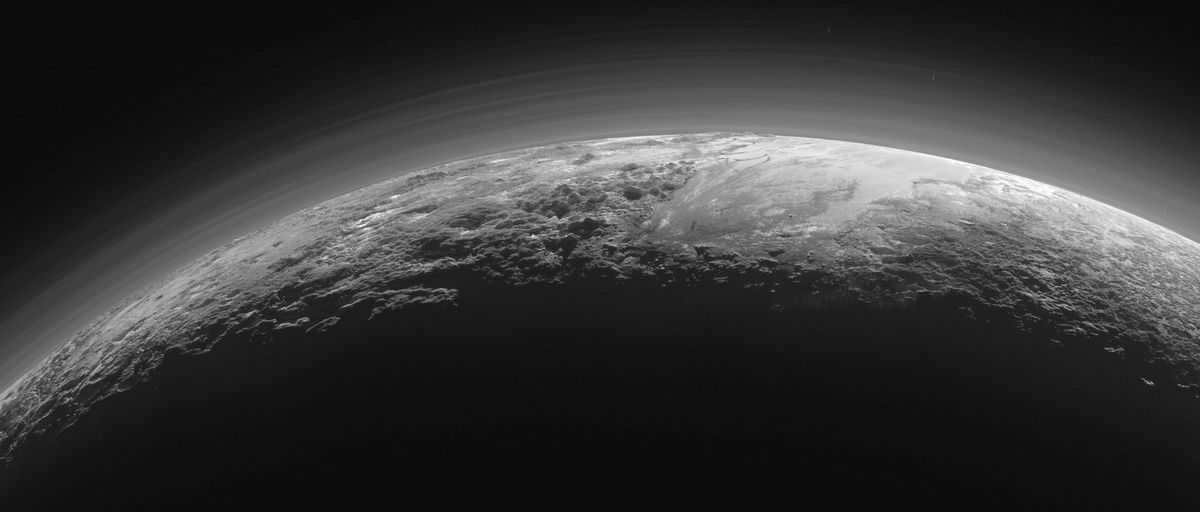
The composition of Pluto’s atmosphere is primarily nitrogen, and it is significantly weaker compared to Earth’s atmosphere, being 100,000 times less dense. While this may not be particularly promising, the mere existence of an atmosphere on Pluto sets it apart from other potential candidates.
Adding to its intrigue, Pluto undergoes a continuous replenishment of its nitrogen-filled atmosphere, suggesting the presence of unknown processes that synthesize nitrogen on the surface of the dwarf planet.
2. Geological activity
Most of us (or at least, the majority) have a perception of Pluto’s surface as being lifeless and devoid of any activity, with countless craters scattered across its landscape. However, the images captured by New Horizons spacecraft present a completely different picture: Pluto boasts a vast array of mountain ranges, deep depressions, canyons, and various indications of geological activity. In fact, some of these mountains reach heights of up to 3 kilometers, suggesting that Pluto was actively undergoing geological changes at least 100 million years ago. It’s worth noting that even our neighboring planet, Mars, ceased its geological activity a long time ago.
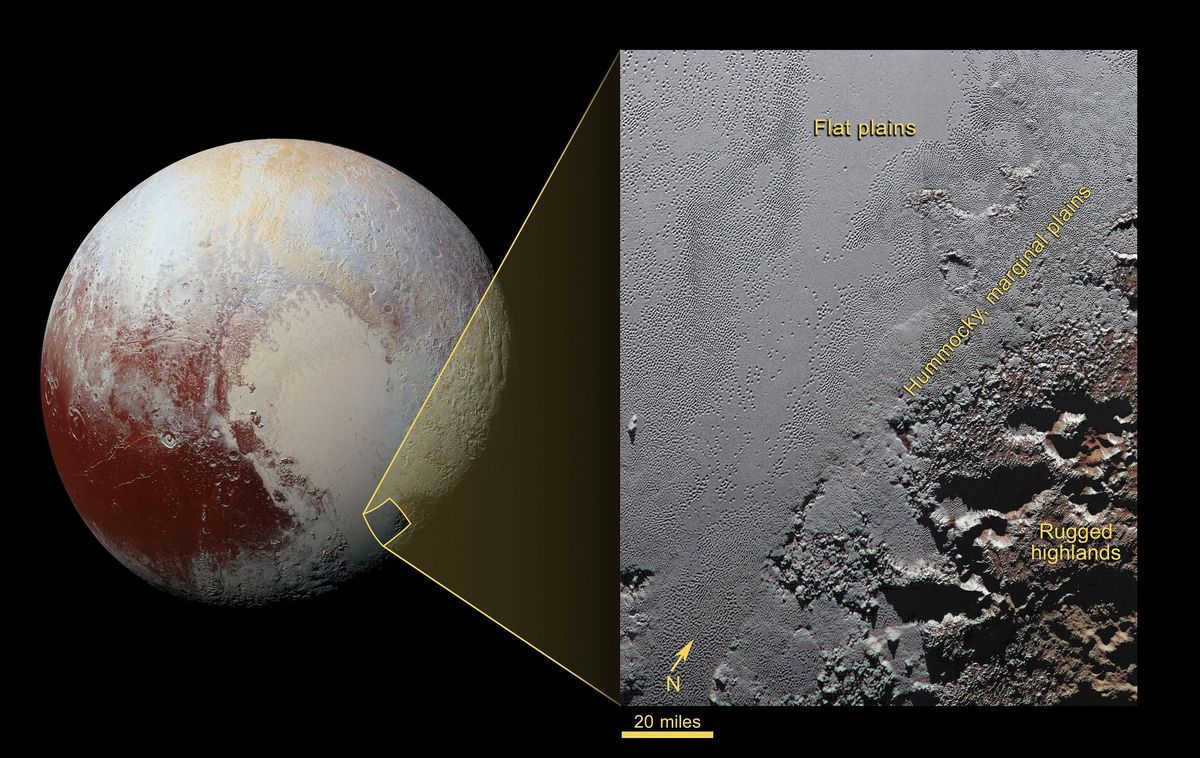
Undoubtedly, all of these processes necessitate a significant amount of energy. On Earth, these processes are carried out by a heated core. However, for Pluto, solar radiation has an almost negligible impact.
Based on the data obtained from the New Horizons mission, it is highly probable that there is a liquid ocean beneath the frozen nitrogen and rocky surface of Pluto. This is the most plausible explanation for the fractures observed on Pluto’s surface.
Some scientists speculate that depending on the season, the liquid ocean freezes and then thaws, resulting in significant disruptions to the planet’s surface. There is also a belief that cryovolcanism, a type of volcanic activity involving the eruption of icy materials, occurs on Pluto.
Is there an error in the third rule?
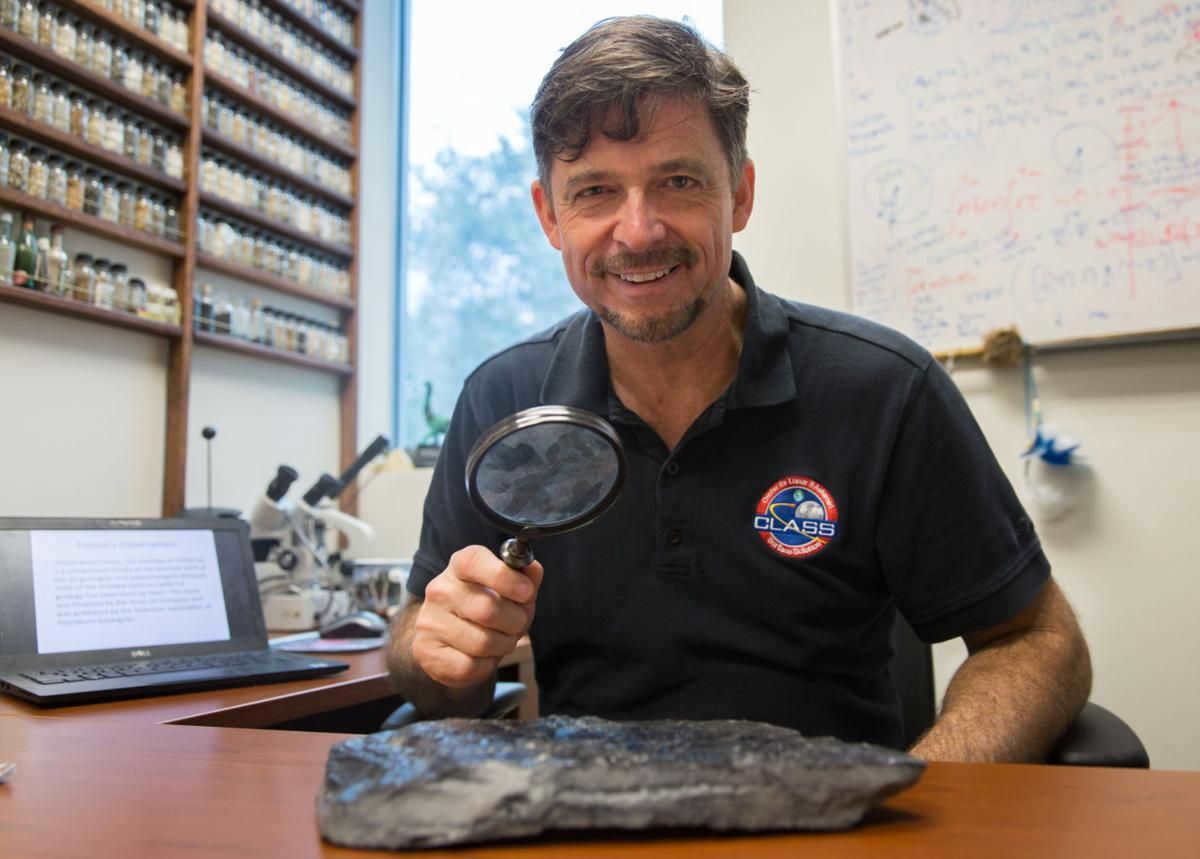
Introducing Philip Metzger – the unofficial “champion” of Pluto, a planetologist at the University of Central Florida (USA). In a recent study published in the journal Icarus, Philip reveals that the conventional standard for categorizing planets based on orbit purity lacks support from the scientific literature.
Philip Metzger meticulously analyzed scientific papers spanning the past two centuries and discovered that since 1802, only one publication utilized the orbit purity criterion for classifying planets, and even then, it was based on unassailable reasoning. Additionally, planetologists have consistently regarded satellites like Titan at Saturn and Europa at Jupiter as planets since the time of Galileo.
“The IAU definition demonstrates that the fundamental entity of planetary science, the planet, is determined based on a concept that is not utilized by any researcher in their studies. Additionally, this definition excludes the second most intricate and captivating planet within our solar system. We have compiled a list of over 100 instances where planetary scientists employ the term ‘planet’ in a manner that does not align with the official definition, but they do so because it serves a functional purpose,” asserts Philipp Metzger.
The scientist’s viewpoint is further supported by the lack of precision in the definition. The International Astronomical Union has not explicitly clarified the meaning of “orbital cleansing”. If one interprets it literally, there are no planets present at all, as none of them are capable of completely and permanently clearing their orbit.





